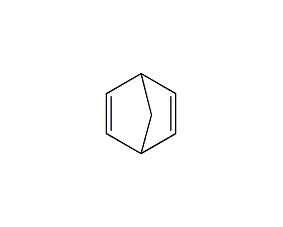2,5-Norbornadiene 2,5-Norbornadiene


Structural formula
| Business number | 03DM |
|---|---|
| Molecular formula | C7H8 |
| Molecular weight | 92.14 |
| label |
Bicyclo[2.2.1]hept-2,5-diene, 2,5-Norbornadiene, Bicycloheptadiene, norbornadiene, Bicyclo[2.2.1]hept-2,5-diene, nor[0XA29C]diene, 3,6-Methano-1,4-cyclohexadiene, 8,9,10-trinorborna-2,5-diene, bicyclo(2.2.1)heptadiene, bicyclo[2.2.1]hepta-2,5-diene,(Norbornadiene), Bicyclo[2.2.1]heptadiene, Norbornadiene, aromatic compounds |
Numbering system
CAS number:121-46-0
MDL number:MFCD00082301
EINECS number:204-472-0
RTECS number:RB6535000
BRN number:506224
PubChem ID:None
Physical property data
1. Properties: liquid
2. Relative density: 0.909
3. Refractive index: 1.4707
4. Flash point (℃): – 21
5. Melting point (℃): -19.1
6. Boiling point (ºC): 90
7. Relative density (25℃, 4℃) : 0.8992 26
8. Normal temperature refractive index (n 20 ): 1.4702
9. Normal temperature refractive index (n <<<<20): 1.4702
10. Relative density (20℃, 4℃): 0.9064
11. Refractive index at room temperature (n25): 1.4681
12. Gas phase standard combustion heat (enthalpy) (kJ·mol-1): -4143.8
13. Gas phase standard claim Heat (enthalpy) (kJ·mol-1): 245.9
14. Liquid phase standard combustion heat (enthalpy) (kJ·mol-1 ): -4110.9
15. Liquid phase standard claims heat (enthalpy) (kJ·mol-1): 213.0
Toxicological data
1. Acute toxicity: Rat inhalation LC50: 14100ppm/8H
Rat peritoneal cavity LD50: 890mg/kg
Mouse oral LD50: 3850mg/kg
Mouse inhalation LC50: 27700ppm/30M
Mouse intravenous injection LD50: 56mg/kg
2. Acute toxicity:
Oral LD50 2850mg/kg(mus)
Inhalation LC50/8H14100ppm/8H(rat)
Main irritating effects:
On skin: Irritating skin and mucous membranes.
On eyes: Irritation effects
Sensitization: No known sensitizing effects.
Ecological data
General Notes
Generally not hazardous to water
Do not discharge materials into the surrounding environment without government permission.
Molecular structure data
5. Molecular property data:
1. Molar refractive index: 29.54
2. Molar volume (cm3/mol): 91.7
3. Isotonic specific volume (90.2K): 231.7
4. Surface tension (dyne/cm): 40.6
5. Dielectric constant: 2.29
p>
6. Dipole moment (10-24cm3):
7. Polarizability: 11.71
Compute chemical data
1. Reference value for hydrophobic parameter calculation (XlogP): 2.1
2. Number of hydrogen bond donors: 0
3. Number of hydrogen bond acceptors: 0
4. Number of rotatable chemical bonds: 0
5. Number of tautomers: none
6. Topological molecule polar surface area 0
7. Number of heavy atoms: 7
8. Surface charge: 0
9. Complexity: 103
10. Number of isotope atoms: 0
11. Determine the number of atomic stereocenters: 0
12. Uncertain number of atomic stereocenters: 0
13. Determine the number of chemical bond stereocenters: 0
14. Number of uncertain chemical bond stereocenters: 0
15. Number of covalent bond units: 1
Properties and stability
1. Basic properties
Liquid. Soluble in petroleum ether, insoluble in water. Relative density 0.909. Melting point -20℃. Boiling point 89℃. Refractive index 1.4707. Flash point -21℃. Flammable. An appropriate amount of 2,6-di-tert-butyl-4-methylphenol or 2,4-dimethyl-6-tert-butylphenol is often added to commercially available products as a stabilizer.
Storage method
2. Storage:
Sealed and stored
Synthesis method
None
Purpose
3. Uses
Prostaglandin synthesis intermediate. Commonly used Diels-Alder reagent. Preparation and isomerization synthesis of tetracycloalkane derivatives